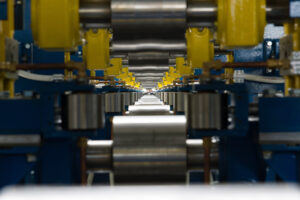Walk into almost any factory and you’ll see the same thing: good people working incredibly hard, surrounded by brilliant machines, and somehow still running behind.
Before Mithryl, I saw this every day. I began my own career at a small manufacturer in Oxfordshire, the kind of place that quietly produces world-class parts for aerospace and automotive customers while operating out of an unassuming shed in the countryside. It was full of brilliant people solving complex problems – but the systems never kept up. Days disappeared into the same processes: reconciling spreadsheets and chasing information between unconnected platforms – by five o’clock, I would realise I had spent the whole day moving information  between systems that supposedly talked to each other.
between systems that supposedly talked to each other.
That experience shaped how I see manufacturing’s biggest challenge today: not a shortage of effort or expertise, but a shortage of connection and context.
The Productivity Puzzle
Everyone knows the headline problem. UK productivity has flatlined for more than a decade. Output per worker is stubbornly below major competitors. The government has thrown billions at innovation funding, digitalisation, and upskilling, but many manufacturers still feel like they are pushing uphill through treacle.
Our new nationwide survey of 1,000 UK manufacturing workers helps explain why.
Ninety-one percent say large chunks of their day are spent on tasks that could have been avoided. Forty-eight percent find those tasks demotivating. And one in four say the frustration makes them want to look for another job.
The problem isn’t attitude or laziness – it’s friction.
Almost half of workers struggle to find the right “how-to” or instruction when they need it, and a similar number said their company is siloed by data and expertise. Many view unnecessary meetings as another source of waste. More than half worry that when experienced colleagues retire, critical know-how will vanish with them.
These are small inefficiencies on paper, but together they make up Britain’s productivity gap in miniature.
What’s Really Behind the Gap
The UK’s productivity problem is not a lack of effort or innovation. It is a lack of integration. Manufacturers in particular have been encouraged for years to “go digital”, and most now have an impressive patchwork of software: an ERP here, a scheduling tool there, maybe a dashboard on top.
But digital does not always mean connected.
The average factory tech stack has grown like ivy, layer upon layer of tools and spreadsheets built by necessity, not design. Each department optimises its own workflow, but few share the same data model or naming conventions. That is how you end up with five systems all insisting they are the source of truth, and none of them agreeing on what a “part” or “batch” actually is.
That is the context gap. And it is what turns smart teams into frustrated ones.
So what does fixing it look like in practice?
Start by tackling the jobs that drain time but add no value. Weekly report exports, copying data between spreadsheets, or re-typing what already exists elsewhere are the usual suspects. Automate the plumbing. No-code tools like Make.com, Workato and Zapier can connect your existing ERP (Enterprise Resource Planning) and MES (Manufacturing Execution System) systems directly to the documents and workflows your teams already use – helping information flow seamlessly rather than being copied by hand.
A single click saved per task might not sound like much, but it compounds fast. Across hundreds of employees and thousands of repetitive actions, it adds up to weeks reclaimed every year.
Pick one digital home for your operational data, a single hub where everything actually lives. Gather what is already out there: SOPs, maintenance logs, inspection sheets, supplier certificates, work orders, and key emails. Make it searchable, linkable, and accessible.
If a maintenance note references a specific machine, its record should be one click away. It sounds simple, but this alone eliminates the “ten tabs for one answer” routine that erodes hours of productive time every week. Treat it as a foundational operational project, not an IT experiment.
Once the information is in one place, organise it logically. Use clear, shared categories and language to describe how your factory works: Activities, Documents, Machines, Materials, Documents, People, Processes. Tag what you have collected with these labels. A PDF becomes a Document tied to a Device. An inspection note becomes an Activity linked to a Process.
These labels form the scaffolding that turn piles of files into a navigable map, the foundation every improvement depends on.
Once things are labelled, start connecting them. A Machine connects to the activity that changed it, that activity links to the document that verifies it, and so on.
This creates the foundation of a knowledge graph – a connected map that shows how everything in your factory fits together. It transforms data from isolated records into a living model of how your operation really works. It transforms your data from isolated records sitting in storage, to a living model of how your operation really works.
Generic chatbots struggle in factories because they do not understand what your data means. They lack context. When AI is connected to structured knowledge graph, it can finally do more than guess. It can understand the context behind every decision tracing issues, suggesting actions, and surfacing insights your teams can trust.
You might be wondering what knowledge graphs are.
A knowledge graph maps the relationships between machines, materials, documents, people, and processes, creating a connected picture of how your factory truly works. At its simplest, it is made up of “nodes” (things) and “edges” (relationships). Those few labels you defined earlier become node types in the graph, helping define what each piece of data is and how it fits together.
The result is a living model of your operations, one that AI can understand, analyse, and learn from.
From Chaos to Clarity
Yes, this is real work, the kind that takes months, not weeks. But the reward is felt across every process, from maintenance to quality to logistics. Start small: one line, one product family, one maintenance area. Build the hub, apply the labels, connect a few high-impact records, and automate two time-sinks. Then review weekly: What did we connect? What did we automate? What got faster?
Momentum builds quickly once people stop guessing and start knowing.
That is exactly why we built Anvil, to do the heavy lifting so manufacturers can begin with a working graph on day one and grow it over time.
The Way Forward for UK Industry
British manufacturing doesn’t lack determination or innovation; it lacks connected foundations. Productivity gains won’t come from squeezing more out of people but from giving them systems that understand how their work fits together.
And here’s the part we often forget: the very technologies now driving the AI revolution, from Turing’s early computing theories to the foundations of modern language models, were born right here in the UK.
This country invented the tools that now power the world’s most advanced factories. If we can rediscover that spirit of practical innovation and apply it to our own industrial base, there’s no reason we can’t lead again.
Roger Zouein is co-founder and CEO of industrial data platform Mithryl. Its product, Anvil, unifies system, machine, and document data into one connected knowledge graph, giving teams the context they need to work faster and smarter.

